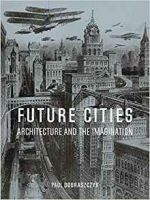Future Cities: Architecture and the Imagination

Future Cities is a philosophically and culturally wide-ranging look at the usefulness of imagined cities. Appropriately for this examination of creativity, its classification of cities into three types is itself rather imaginative: unmoored (in the water or air), vertical (skyscrapers and subterranean structures) and unmade (ruins). The text is accompanied by a number of images that usefully show how visual artists have imagined future cities (although they’d be even more useful presented in colour).
Paul Dobraszczyk argues that all this isn’t just the material of sci-fi films and unreadable novels. An architectural drawing or city plan involves a kind of urban imagining, so it’s worthwhile to think about the links to practice. He writes, “Once a city becomes so large and complex that it exceeds one’s ability to comprehend it in a single mental image, then the imagination has to take over – to fill in the gaps in our mental perception of the vast urban environment” (pages 9–10).
There’s a potentially subversive power in envisioning alternatives to the status quo. This doesn’t mean that there’s always an egalitarian bent to alternative-city fiction, though. For instance, there’s a disproportionate amount of climate fiction centred on cities that aren’t the worst affected by climate change, like Washington, DC and London (e.g. Paolo Bacigalupi’s Drowned Cities and J.G. Ballard’s The Drowned World). And urbanists like Vanessa Watson have written about how master plans and other forms of imagining urban development can be deeply exclusionary.
But overall, popular culture and architecture helpfully allow the public to see beyond the world’s environmentally precarious state: “The sheer uncertainty about the possible effects of human activity on the future of the planet forces us to reach for the imagination in sketching out these alternatives” (page 13).
And, crucially, these imagined futures stimulate empathetic engagement (page 46):
“Climate change scientists may attempt to predict likely outcomes of rising sea levels on cities using empirical evidence, but those predictions are usually stated in bald statistical terms, avoiding engagement with the emotional consequences of presenting such alarming news. Climate change fictions, whether they take the form of texts, images or architectural conjecture, fill the gap here, making room for other kinds of forecasts, not of a predictive nature, but centred on the creation of future narratives – stories that we can latch onto in terms of imagining what it would be like to live in these possible future urban worlds.”
Further reading:
Hewitt, Lucy and Stephen Graham (2014), “Vertical cities: representations of urban verticality in twentieth-century science fiction literature”, Urban Studies Vol 52, No 5, pages 928–932, available at https://www.researchgate.net/publication/270711909_Vertical_cities_Repre....
Jackson, Mark and Veronica della Dora (2009), ““Dreams so big only the sea can hold them”: Man-made islands as anxious spaces, cultural icons, and travelling visions”, Environment and Planning A Vol 41, No 9, pages 86–104, available at https://www.researchgate.net/publication/46559741_Dreams_so_big_only_the....
Watson, Vanessa (2013), “African urban fantasies: dreams or nightmares?”, Environment and Urbanization Vol 26, No 1, pages 215–231, available at https://journals.sagepub.com/doi/full/10.1177/0956247813513705.
Yusoff, Kathryn and Jennifer Gabrys (2011), “Climate change and the imagination”, Wiley Interdisciplinary Reviews: Climate Change Vol 11, No 4, pages 516–534, available at https://www.academia.edu/1006118/Climate_change_and_the_imagination.
Book note prepared by Christine Ro
Search the Book notes database
Our Book notes database contains details and summaries of all the publications included in Book notes since 1993 - with details on how to obtain/download.
Use the search form above, or visit the Book notes landing page for more options and latest content.
For a searchable database for papers in Environment and Urbanization, go to http://eau.sagepub.com/

